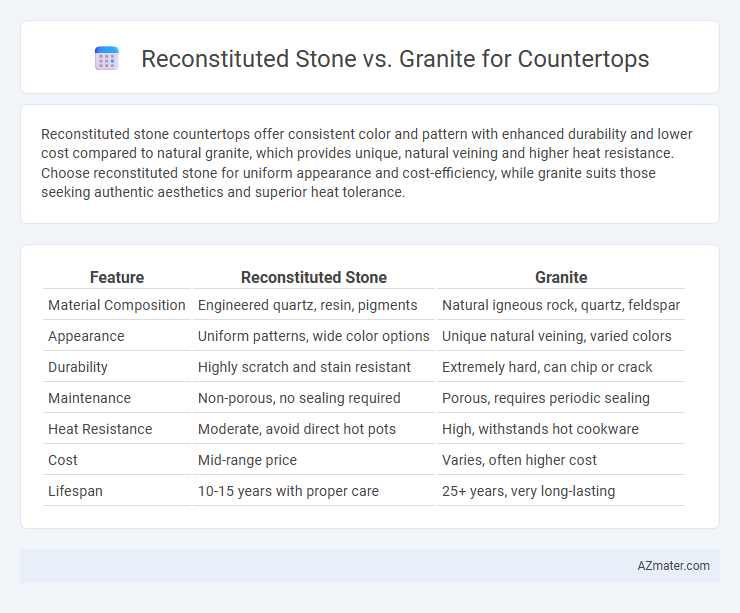Reconstituted stone countertops offer consistent color and pattern with enhanced durability and lower cost compared to natural granite, which provides unique, natural veining and higher heat resistance. Choose reconstituted stone for uniform appearance and cost-efficiency, while granite suits those seeking authentic aesthetics and superior heat tolerance.
Table of Comparison
| Feature | Reconstituted Stone | Granite |
|---|---|---|
| Material Composition | Engineered quartz, resin, pigments | Natural igneous rock, quartz, feldspar |
| Appearance | Uniform patterns, wide color options | Unique natural veining, varied colors |
| Durability | Highly scratch and stain resistant | Extremely hard, can chip or crack |
| Maintenance | Non-porous, no sealing required | Porous, requires periodic sealing |
| Heat Resistance | Moderate, avoid direct hot pots | High, withstands hot cookware |
| Cost | Mid-range price | Varies, often higher cost |
| Lifespan | 10-15 years with proper care | 25+ years, very long-lasting |
Introduction to Countertop Materials
Reconstituted stone countertops combine crushed natural stone with resin, offering uniform patterns and enhanced durability, making them a versatile option for kitchens. Granite, a natural igneous rock, boasts unique veining and exceptional hardness, providing a timeless and heat-resistant surface ideal for heavy use. Both materials require sealing to prevent staining, but reconstituted stone offers greater consistency while granite delivers authentic natural beauty.
What is Reconstituted Stone?
Reconstituted stone is an engineered material made by combining crushed natural stone fragments with resin and pigments to mimic the appearance of natural stone while offering enhanced durability and uniformity. Unlike granite, which is quarried as solid slabs, reconstituted stone allows for greater customization in color, pattern, and thickness. This material is non-porous and resistant to stains and scratches, making it a practical choice for kitchen countertops requiring low maintenance.
What is Granite?
Granite is a natural igneous rock composed mainly of quartz, feldspar, and mica, known for its durability and unique, granular appearance. Its natural formation creates a wide range of color variations and patterns, making each countertop visually distinct. Granite countertops resist heat, scratches, and stains, making them a popular choice for kitchen surfaces.
Appearance and Aesthetic Differences
Reconstituted stone offers a consistent and customizable appearance with uniform patterns and color options, making it ideal for modern or contemporary kitchen designs. Granite features natural veining and unique mineral formations, providing a one-of-a-kind, organic aesthetic that enhances traditional and rustic interiors. The choice between reconstituted stone and granite depends on whether a more controlled, sleek look or a natural, varied texture is desired for the countertop.
Durability and Strength Comparison
Reconstituted stone countertops, made from crushed natural stone mixed with resin, offer comparable strength and enhanced impact resistance compared to natural granite, making them highly durable for daily kitchen use. Granite is a natural igneous rock with exceptional hardness and scratch resistance, often rated around 6-7 on the Mohs scale, while reconstituted stone varies but typically achieves similar or superior durability due to controlled manufacturing processes. Both materials resist heat and wear well, but reconstituted stone provides uniform structure reducing the likelihood of fractures and chips compared to the natural variability in granite slabs.
Maintenance and Cleaning Requirements
Reconstituted stone countertops require less maintenance compared to granite, as they are non-porous and resist staining without the need for regular sealing. Granite countertops demand periodic sealing every 1-2 years to prevent moisture absorption and staining, which increases upkeep efforts. Cleaning reconstituted stone involves mild soap and water, while granite benefits from pH-neutral cleaners to preserve the stone's natural finish and avoid etching.
Cost Comparison: Reconstituted Stone vs Granite
Reconstituted stone countertops typically cost between $40 to $80 per square foot, offering a more affordable option compared to natural granite, which ranges from $50 to $100 per square foot. The lower price of reconstituted stone stems from its engineered composition, allowing for consistent quality and less expensive installation. Granite's cost is influenced by factors such as quarry location, slab rarity, and thickness, often making it a premium choice in kitchen remodeling projects.
Environmental Impact and Sustainability
Reconstituted stone countertops are made from crushed natural stone combined with resin, allowing the use of recycled materials and reducing quarry waste compared to granite, which is extracted directly from quarries with significant environmental disruption. The manufacturing of reconstituted stone consumes less energy and generates fewer carbon emissions than granite extraction and processing, making it a more sustainable choice. Reconstituted stone's versatility and consistent quality also result in less material waste during fabrication, further minimizing its environmental footprint relative to granite countertops.
Suitability for Kitchens and Bathrooms
Reconstituted stone offers a non-porous surface that resists stains and bacteria, making it highly suitable for kitchen countertops where hygiene is critical. Granite, known for its natural hardness and heat resistance, excels in both kitchens and bathrooms but requires periodic sealing to maintain its durability against moisture. Both materials provide aesthetic appeal, with reconstituted stone offering uniform patterns and granite showcasing unique natural veining.
Choosing the Right Countertop for Your Home
Reconstituted stone countertops offer uniform color, enhanced durability, and lower maintenance compared to natural granite, making them an ideal choice for homeowners seeking consistency and affordability. Granite provides unique, natural patterns with exceptional heat resistance and scratch durability, preferred for luxury kitchens and timeless aesthetics. Selecting between reconstituted stone and granite depends on budget, design preference, and the desired balance between natural beauty and engineered reliability.

Infographic: Reconstituted stone vs Granite for Countertop
 azmater.com
azmater.com